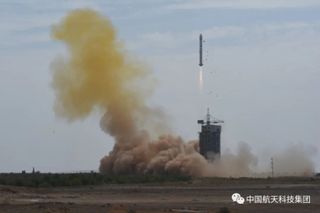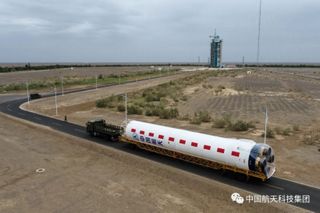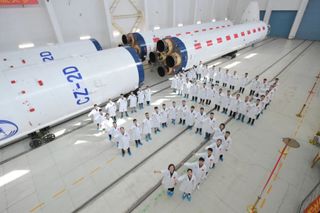China launches 2 satellites from Gobi Desert
China is continuing its rapid rate of space launches with its 22nd mission of 2020.
China launched a new Earth observation satellite on Thursday (Aug. 6), with a small companion satellite from Tsinghua University joining the ride.
A Long March 2D rocket lifted off from Jiuquan in the Gobi Desert at 12:01 p.m. local time Aug. 6 (12:01 a.m. EDT, 0401 GMT).
Related: The latest news about China's space program

The main payload was Gaofen 9 (04), an optical observation satellite capable of returning high resolution images, showing features as small as 3 feet (1 meter) across.
Data gathered by the satellite will inform land surveys, city planning, land-rights confirmation, road-network design, crop-yield estimation and disaster prevention and mitigation, according to Chinese media.
Today's payload is the fourth Gaofen 9 satellite to be launched; two of its predecessors also launched this year. It will join a larger suite of Gaofen and other Earth-observing satellites as part of the China High-resolution Earth Observation System (CHEOS).
Sign up for the Live Science daily newsletter now
Get the world’s most fascinating discoveries delivered straight to your inbox.

Riding along with the Gaofen 9 payload was the Tsinghua gravity and atmosphere scientific satellite, or Q-SAT, which was developed by Tsinghua University in Beijing. The project will verify technology and will measure atmospheric density and collect gravity field data, according to Xinhua.
The China Aerospace Science and Technology Corporation (CASC) developed and manufactured the Gaofen 9 (04) satellite. Shanghai Academy of Spaceflight Technology (SAST), one of the major institutes under CASC, manufactured the two-stage Long March 2D rocket. The corporation's main rocket-manufacturing facilities are in Beijing and Shanghai.

Today's launch was the 50th for the Long March 2D, which debuted in August 1992. The vehicle has suffered just one partial failure, in 2016, when three satellites were sent into lower-than-intended orbits.
China has carried out 22 launches in 2020, including a test flight of the Long March 5B for space-station missions and the launch of the Tianwen-1 Mars mission. Three of the 22 launches ended in failure.
The country led the world in launches in 2018 and 2019, launching 39 and 34 times respectively. CASC said in January it would aim for around 40 launches in 2020, with commercial launch service providers like Expace and Galactic Energy to carry out their own missions.
Follow us on Twitter @Spacedotcom and on Facebook.

Andrew is a freelance space journalist with a focus on reporting on China's rapidly growing space sector. He began writing for Live Science sister site Space.com in 2019, and he also writes for SpaceNews, IEEE Spectrum, National Geographic, Sky & Telescope, New Scientist and others. Andrew first caught the space bug when, as a youngster, he saw Voyager images of other worlds in our solar system for the first time. Away from space, Andrew enjoys trail running in the forests of Finland.
